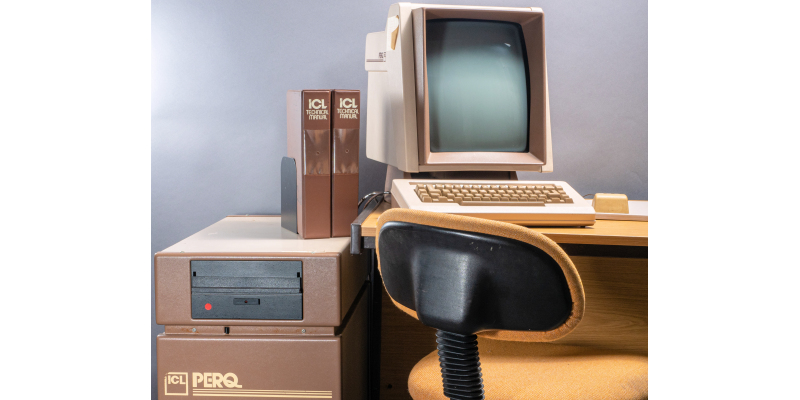
ICL PERQ 1
Look at the monitor, what makes it different?
This was an early “workstation”; a powerful stand-alone computer incorporating “rich graphics”.
Compared to today Rich Graphics would mean “basic graphics”, but at the time it was very special. It was the first graphics computer and as such, this is a rare example. Did you spot that monitor is in the portrait orientation? The screen is 768x1024 pixel grayscale.
It was launched in 1979. International Computers Ltd. (ICL) bought the design of the machine from the US with the UK Research Council’s help, to use on research projects.
The computer was unusual in its writeable control store, this allowed the user to design an instruction set specifically for their application area. The main clock ran at 5.88 MHz and the machine came with a maximum of 64K RAM. In addition, a 24Mb hard disk and an 8” floppy drive.
No mice were available then (not commercially sold until 1982), but a graphics tablet was provided for the system.
Related links
The PERQ, also referred to as the Three Rivers PERQ or ICL PERQ, was a pioneering workstation computer produced in the late 1970s through the early 1980s. In June 1979, the company took its very first order from the UK's Rutherford Appleton Laboratory and the computer was officially launched in August 1979 at SIGGRAPH in Chicago. It was the first commercially produced personal workstation with a Graphical User Interface. The design was heavily influenced by the original workstation computer, the Xerox Alto, which was never commercially produced. The origin of the name "PERQ" was chosen both as an acronym of "Pascal Engine that Runs Quicker," and to evoke the word perquisite commonly called perks: employee additional benefits!
The PERQ was used in a number of academic research projects in the UK during the 1980s. 3RCC was renamed PERQ System Corporation in 1984. It went out of business in 1986, largely due to competition from other workstation manufacturers such as Sun Microsystems, Apollo Computer and Silicon Graphics.
The PERQ CPU was a microcoded discrete logic design, rather than a microprocessor. It was based around 74S181 bit-slice ALUs and an Am2910 microcode sequencer. The PERQ CPU was unusual in having 20-bit wide registers and a writable control store (WCS), allowing the microcode to be redefined. The CPU had a microinstruction cycle period of 170 ns (5.88 MHz).
The original PERQ (also known as the PERQ 1), was housed in a pedestal-type cabinet with a brown fascia and an 8-inch floppy disk drive mounted horizontally at the top.
The PERQ 1 CPU had a WCS comprising 4k words of 48-bit microcode memory. The later PERQ 1A CPU extended the WCS to 16k words. The PERQ 1 could be configured with 256 kB, 1MB or 2 MB of 64-bit-wide RAM (accessed via a 16-bit bus), a 12 or 24 MB, 14-inch Shugart SA-4000-series hard disk, and an 8-inch floppy disk drive. The internal layout of the PERQ 1 was dominated by the vertically mounted hard disk drive. It was largely this that determined the height and depth of the chassis.
A basic PERQ 1 system comprised a CPU board, a memory board (incorporating the framebuffer and monitor interface) and an I/O board (IOB, also called CIO). The IOB included a Zilog Z80 microprocessor, an IEEE-488 interface, an RS-232 serial port, hard and floppy disk interfaces and speech synthesis hardware. PERQ 1s also had a spare Optional I/O (OIO) board slot for additional interfaces such as Ethernet.
A graphics tablet was standard. Most PERQ 1s were supplied with an 8½ ×11-inch, 768×1024 pixel portrait orientation white phosphor monochrome monitor. The machine was optimised to run PASCAL and ran at about 1MIP. The operating system was a UNIX version called PNX.